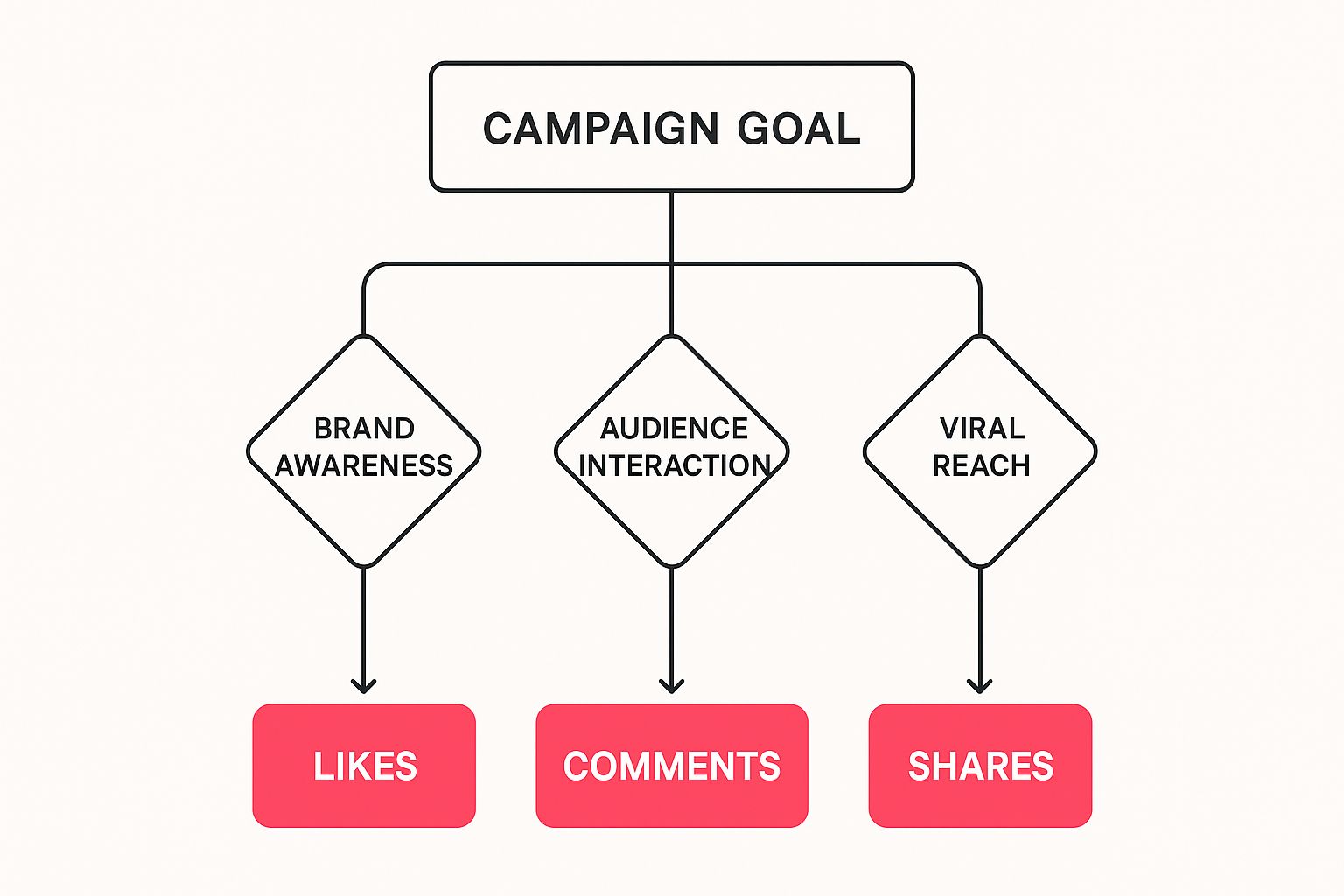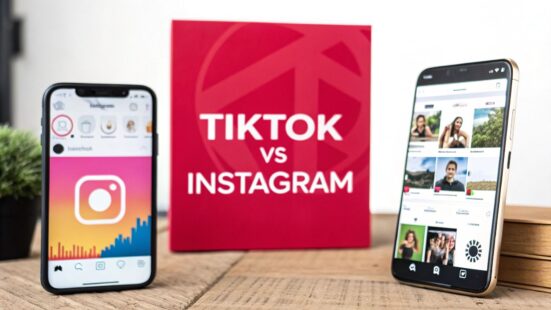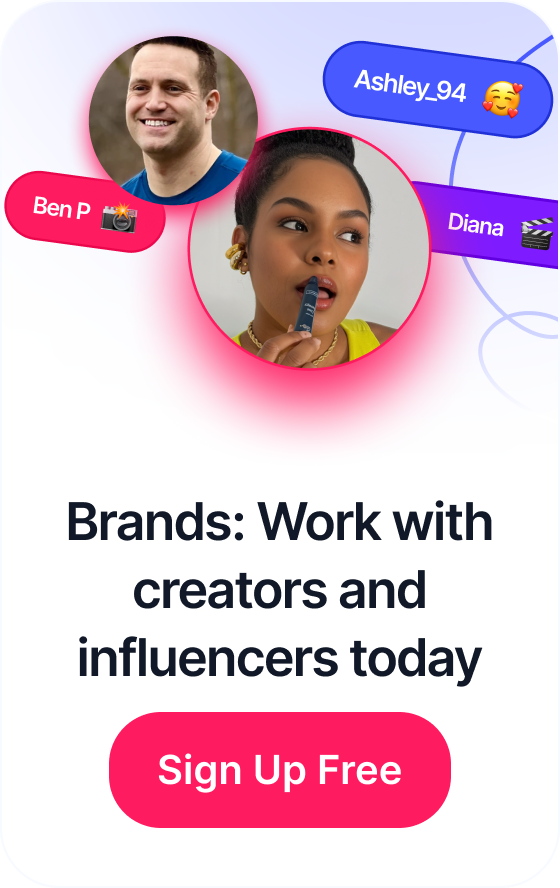 Content Approval Workflow: From Chaos to Seamless Efficiency
Content Approval Workflow: From Chaos to Seamless Efficiency
Table of Contents
Understanding The Difference Between TikTok and Instagram
To really understand the difference between TikTok and Instagram, we need to look beyond a simple list of features and examine their core philosophies. These platforms are built on fundamentally different ideas about content discovery and social interaction, which in turn dictates how brands and users engage with them. One is designed as a pure entertainment engine, while the other functions more like a curated social portfolio.
This core distinction shapes the entire user experience. TikTok is primarily an entertainment-first discovery platform. Its success is built on an algorithmic model that values content quality and engagement speed above all else. This means a creator with zero followers can achieve massive, overnight reach if their video resonates with the platform’s fast-moving, trend-driven culture. The “For You” Page is the best example of this, prioritizing unexpected discovery over your existing social connections.
For instance, the TikTok feed is a continuous stream of new, algorithmically chosen content designed for pure consumption and enjoyment.
This interface shows how the platform prioritizes immediate video engagement, making the content itself the star, not always the creator behind it.
Instagram as a Social Showcase
In contrast, Instagram operates as a curated lifestyle showcase. While it has integrated discovery features like the Explore page and Reels to compete, its foundation is still rooted in social proof and relationship building. The platform’s structure encourages users to build and nurture a following, where content from accounts you follow is prioritized. Success on Instagram is often a slower process, rewarding visual consistency, polished brand storytelling, and sustained community engagement over time.
This difference in platform philosophy has major implications for marketers. One of the clearest distinctions is in user demographics and engagement, particularly with younger audiences. As of 2025, TikTok has solidified its position as the most-used social media platform among Gen Z in the United States, with over 150 million monthly active users. Instagram remains a strong competitor with 148 million U.S. users, largely by adapting its model to include more video-focused content. You can learn more about these figures and other social media platform statistics on TekRevol.com.
Ultimately, grasping this fundamental split—TikTok as a discovery engine versus Instagram as a social network—is essential. It explains why a raw, authentic video might thrive on TikTok but fall flat on Instagram’s more polished feed. Choosing the right platform means aligning your content strengths and business goals with the underlying culture of either authentic entertainment or curated lifestyle.
Audience Behavior and Platform Usage Patterns
The true distinction between TikTok and Instagram becomes clear when you look at how people actually use them. The way audiences find, view, and interact with content reveals unique behavioral patterns that have major consequences for any brand or creator. These habits offer more insight than simple demographics, showing why someone opens one app over the other at different times.
On one hand, TikTok is built around discovery-driven behavior. Users don’t necessarily open the app to see content from people they follow; they open it to be entertained by a constant stream of videos curated by the algorithm. It’s a passive, lean-back experience, almost like channel surfing. This fosters a culture of non-stop novelty, where users spend an average of 95 minutes per day scrolling the “For You” page, looking for new trends, sounds, and creators. Engagement is often impulsive—a quick like or a share—driven by the video’s immediate entertainment factor.
Intentional Browsing vs. Algorithmic Surfing
In contrast, Instagram users often show more intentional browsing patterns. While Reels adds an element of discovery, the platform’s foundation is still the user’s curated social network. People frequently open the app with a purpose: to check a favorite creator’s profile, watch Stories from friends, or research a brand they’re thinking of buying from. This behavior is more active and goal-oriented, blending social connection with product investigation.
The Instagram profile page, as seen below, is designed for this intentionality. It provides clear access to feed posts, Reels, and tagged content, letting users evaluate a brand’s visual style and community interaction.
This organized structure encourages people to look into a brand’s history and social proof, a sharp contrast to TikTok’s fast-moving, feed-first experience.
This difference in behavior directly affects the pace of content consumption. TikTok thrives on spontaneity and high-speed viral moments, where one video can dominate a brand’s presence for a week. Instagram, on the other hand, rewards a more measured approach, favoring consistent brand identity and long-term community building.
To better understand these subtle differences, the following table details specific user behaviors and what they mean for your strategy.
Platform Usage Behavior Comparison
Detailed analysis of how users discover, consume, and engage with content across TikTok and Instagram
| Behavior Pattern | TikTok User Approach | Instagram User Approach | Strategic Implications |
|---|---|---|---|
| Content Discovery | Primarily through the “For You” page algorithm; a passive discovery model where new content finds the user. | A mix of content from followed accounts, the Explore Page, and direct profile searches; more active and intentional. | For TikTok, focus on broad-appeal, trend-based content that can be surfaced to anyone. For Instagram, build a consistent brand aesthetic that appeals to your target follower. |
| Session Intent | To be entertained and pass the time; users are actively seeking novelty, humor, and surprises. | A blend of social connection (checking on friends), lifestyle inspiration, and direct product research or brand vetting. | Create entertaining, attention-grabbing content for TikTok. On Instagram, provide value, build trust, and facilitate product discovery. |
| Engagement Type | High-volume but low-effort actions like likes and quick shares; participation in trends is a common form of engagement. | More thoughtful interactions such as saves, detailed comments, and direct messages; focused on community interaction. | Aim for shareable, viral-ready formats on TikTok. On Instagram, create content that encourages saves and fosters genuine dialogue with your audience. |
Ultimately, the key insight is that TikTok is a content-first platform, while Instagram remains a creator-first platform. On TikTok, a single great video can reach millions regardless of who posted it. On Instagram, a strong creator profile is essential for building a loyal audience that will consistently engage with your content over time.
Content Creation and Production Requirements
The key difference between TikTok and Instagram is clear when you look at what it takes to create content for each. Although both are visual platforms, the expectations around production quality, creative style, and time commitment are completely different. One thrives on spontaneous, trend-driven authenticity, while the other rewards polished, strategically planned visuals. This split directly affects how a brand needs to plan, produce, and publish its posts.

Tools like Canva offer templates for both platforms, but the creative approach is what matters. For Instagram, templates are great for keeping a consistent brand look. For TikTok, a template might just be the starting point for jumping on a viral trend.
The TikTok Production Ethos: Raw and Reactive
TikTok’s real power is that it makes video creation accessible to everyone. The app’s built-in editing tools, trending audio library, and easy-to-use effects let anyone with a smartphone create dynamic content. Here, production value takes a backseat to creative ideas and cultural relevance. Authenticity is the most valuable currency.
The platform gives a boost to creators who can:
- React quickly: Content is often made on the fly in response to a new sound, challenge, or meme format.
- Prioritize storytelling over polish: A funny or emotional story shot in a messy bedroom will almost always do better than a high-budget, sterile corporate video.
- Embrace experimentation: TikTok is where new social media formats are constantly being born. Brands willing to try raw, behind-the-scenes, or unscripted videos often see the best results.
This reactive approach means less time is spent on planning and more on watching platform trends. The goal is to produce a higher volume of timely content, not a handful of perfect assets.
Instagram’s Strategic Content Ecosystem
On the other hand, Instagram calls for a more calculated and varied content plan. Success isn’t just about one viral Reel; it’s about creating a unified experience across different formats like Feed posts, Stories, and even longer videos. This makes the production needs more complex.
A strong Instagram presence often requires careful planning, including content calendars, aesthetic mood boards, and adapting creative assets for various placements. This structured approach means brands invest more time in pre-production to ensure everything looks consistent and aligns with the brand.
Managing this requires a solid process. For teams aiming to produce high-quality assets efficiently across these formats, learning how to scale content creation is a key skill for long-term growth. Using different social media content creation tools can also help simplify workflows, from brainstorming ideas to scheduling posts. This ensures that whether you’re chasing TikTok’s viral moments or building Instagram’s curated aesthetic, your production is both efficient and effective.
Algorithm Performance and Engagement Dynamics
https://www.youtube.com/embed/9n8jI2267MM
The algorithmic engines of TikTok and Instagram reveal the most critical difference between the two platforms. Each operates on a distinct philosophy for content delivery, which directly shapes how brands can grow an audience and how users find new content. One platform is built for entertainment velocity, while the other balances new discovery with existing relationships.
TikTok’s Content-First Discovery Engine
TikTok‘s algorithm is engineered for a single primary goal: to keep users watching. It is heavily weighted toward engagement velocity and completion rates—meaning it tracks how quickly a video gains traction and how many viewers watch it to the end. This system creates a meritocratic playing field where a video’s quality and its power to grab immediate attention are more important than the creator’s follower count. A completely new account has a real chance of going viral if its content resonates.
This system rewards content that is:
- Instantly engaging: The first three seconds are absolutely essential to stop a user from scrolling past.
- Trend-aligned: Using trending sounds and popular formats gives a major boost to visibility.
- Highly re-watchable: Videos with high completion rates and those that loop seamlessly are often promoted to broader audiences.
However, this algorithmic model also creates unpredictability. A video format that works wonders one week might fall flat the next, requiring creators to constantly adapt. For those wanting to better understand the mechanics behind visibility, there are excellent resources on understanding the TikTok algorithm. Ultimately, this system is designed for broad, rapid-fire reach.
Instagram’s Relationship-Focused Algorithm
The algorithm on Instagram, while continuously evolving, still places considerable emphasis on existing user relationships. It tries to strike a balance between showing content from accounts a user already follows and suggesting new content through Reels and the Explore page. As a result, accounts with larger, more established followings often have an edge in organic reach. The algorithm analyzes who you interact with the most—whose posts you like, comment on, and save—to prioritize their content in your feed.
This structure leads to more predictable, though often slower, growth. It rewards consistent engagement and long-term community building. While an Instagram Reel can certainly go viral, sustained reach is more closely linked to nurturing your follower base.
One of the clearest indicators of these algorithmic differences is the engagement rate. Benchmarks from 2025 show that TikTok’s average engagement rates fall between 2% and 6%, with some analyses reporting numbers closer to 6%. In stark contrast, Instagram’s average engagement rate often struggles to break 1%, typically hovering between 0.5% and 0.8%. You can read more analysis on TikTok and Instagram engagement rates on RecurPost.com. Brands aiming to improve their performance on Instagram should study the Instagram engagement rate formula and the various factors that influence it.
To help you decide which platform aligns better with your goals, the table below breaks down the key performance metrics and strategic implications of each algorithm.
Algorithm Performance Metrics Analysis
Comprehensive breakdown of engagement rates, reach potential, and content discovery factors for strategic planning
| Performance Factor | TikTok Characteristics | Instagram Characteristics | Strategic Considerations |
|---|---|---|---|
| Primary Goal | Maximize user watch time and engagement velocity. | Balance content from followed accounts with new discovery. | TikTok is for rapid, broad exposure. Instagram is for cultivating a loyal community. |
| Content Discovery | Primarily through the “For You Page” (FYP), driven by content quality, not followers. | A mix of Feed (followed accounts), Reels, and Explore Page (suggestions). | TikTok offers a higher chance for new accounts to go viral. Instagram favors established accounts. |
| Average Engagement Rate | High, typically 2% – 6%. | Lower, often 0.5% – 0.8%. | Brands seeking high interaction per post will find TikTok more effective. |
| Reach Predictability | Highly unpredictable; can be explosive or minimal. | More predictable and steady, tied to follower growth. | Instagram provides more stable forecasting for campaigns, while TikTok offers higher risk/reward. |
| Key Signals for Virality | Video completion rate, re-watches, shares, and trend alignment. | Likes, comments, saves, and shares from established followers. | On TikTok, focus on hook-and-loop content. On Instagram, focus on shareable, community-driven content. |
| Content Lifespan | Short; content is pushed heavily for a few days then fades. | Longer; posts can resurface via hashtags and the Explore Page over time. | Instagram content has more staying power, while TikTok demands a higher content creation frequency. |
In short, the choice between TikTok and Instagram’s algorithms depends entirely on your brand’s objectives. If your goal is rapid, widespread brand awareness and you have the resources for fast-paced content creation, TikTok’s discovery engine is your best bet. If you are focused on building a dedicated community and prefer a more stable, long-term growth strategy, Instagram’s relationship-centric algorithm is the more suitable choice.
Business Applications and Marketing Effectiveness
When comparing TikTok and Instagram for business, their commercial uses and marketing effectiveness present two different approaches for brands. The decision isn’t about which one is “better,” but rather which platform’s unique strengths align with a brand’s specific goals. One is designed for building cultural relevance and top-of-funnel awareness, while the other functions as a mature, full-funnel marketing machine.
Instagram shines with its established business infrastructure, which supports strategies from initial discovery all the way to the final purchase. Its well-developed ecosystem gives brands a complete set of tools designed for commerce.
- Full-Funnel Marketing: Instagram allows brands to guide customers through the entire sales journey. A user might discover a product in a Reel, learn more from a detailed feed post, see it in action in a Story, and then buy it directly through an integrated Instagram Shop—all without ever leaving the app.
- Established Influencer Ecosystem: The platform hosts a well-developed influencer marketing landscape. Brands can partner with creators who have built long-term trust with their audiences, resulting in more predictable campaign outcomes. Learning how to measure influencer marketing ROI is a key practice that can sharpen this strategy.
- Direct Conversion Tools: With features like product tags, in-app checkout, and shopping ads, Instagram is built to drive direct sales. This makes it a strong choice for e-commerce and direct-to-consumer brands looking for measurable results.
The screenshot below from Instagram’s business portal shows its focus on providing a complete toolset for growth, engagement, and conversion.

This dedication to business solutions makes Instagram a reliable option for brands that need to track performance across the entire marketing funnel.
TikTok’s Role in Brand Awareness and Cultural Relevance
In contrast, TikTok’s primary business value is in creating mass brand awareness and establishing cultural relevance, especially with younger audiences. The platform operates as an entertainment-first space, meaning brands must adopt a different mindset to find success. On TikTok, the goal isn’t direct selling; it’s becoming part of the culture.
Brands succeed on TikTok by creating content that doesn’t feel like a traditional advertisement. This involves participating in trending challenges, using popular sounds, and sharing authentic stories that entertain or connect emotionally. For instance, a brand might go viral with a behind-the-scenes video or a funny take on a current meme.
While TikTok is growing its e-commerce capabilities with TikTok Shop, the primary user intent remains entertainment, not shopping. This makes direct sales conversion more of a secondary benefit than a primary objective.
For marketers weighing their paid campaign options, a comprehensive comparison of TikTok and Facebook Ads Managers offers useful details on platform-specific advertising, which is also relevant for understanding Instagram’s ad system. Ultimately, businesses face a strategic choice: use TikTok for its potential for explosive, top-of-funnel reach, or use Instagram’s integrated tools for more controlled, full-funnel campaigns. Often, the best strategy involves using both platforms for what they do best.
Platform-Specific Strategy Development
Creating a successful social media presence means understanding the unique culture and rules of each platform. The core difference between TikTok and Instagram becomes crystal clear here. A strategy that works wonders on one will almost certainly fall flat on the other without major adjustments, as each platform rewards different creative styles and planning methods.
Crafting a TikTok Strategy: Agility and Authenticity
A winning TikTok strategy is built on three key elements: trend identification, authentic storytelling, and rapid content creation. The platform moves incredibly fast, and brands need to be nimble to keep pace. Success isn’t about perfectly planned content calendars; it’s about inserting your brand into the current conversation. This means actively watching for trending sounds, joining relevant challenges, and making content that feels genuinely entertaining, not like a sales pitch.
The essential parts of a TikTok strategy are:
- Constant Monitoring: Spend time daily on the “For You” page to spot new sounds, formats, and conversations.
- High-Volume, Low-Polish Content: Prioritize a steady flow of content over a few flawless videos. The algorithm favors consistency and trying new things.
- Authenticity Over Aesthetics: Users connect with raw, relatable content. Behind-the-scenes videos, employee features, and user-generated content often do better than big-budget ads.
Building an Instagram Strategy: Cohesion and Community
In contrast, a strong Instagram strategy requires more structured, long-term planning across its various formats. While Reels demand a degree of spontaneity, the platform as a whole still values a strong brand identity and visual consistency. The goal is less about chasing every trend and more about creating a cohesive brand world that your audience connects with. This involves aligning your feed’s look, boosting engagement with Stories, using Reels for discovery, and actively nurturing your community.
A solid Instagram strategy involves:
- Cross-Format Coordination: Plan how your content will work together across the grid, Stories, and Reels to tell one consistent brand story.
- Aesthetic Discipline: Keep a consistent visual style so your brand is immediately recognizable. This builds brand equity and encourages people to follow you.
- Community Cultivation: Use interactive tools like polls, Q&As, and direct messages to build real relationships. The aim is to create a loyal following, not just collect surface-level metrics.
This decision tree helps visualize how campaign goals connect to platform metrics, highlighting where to focus your efforts.

The image shows that a goal like “Viral Reach” depends heavily on shares—a metric often easier to achieve on a discovery-first platform like TikTok. The following table provides a more detailed look at the practical differences in executing your strategy.
To help you decide where to focus your resources, this table breaks down the strategic components for each platform.
Strategic Framework Comparison
Detailed breakdown of content strategy elements, optimization tactics, and success metrics for each platform
| Strategy Component | TikTok Best Practices | Instagram Best Practices | Implementation Priority |
|---|---|---|---|
| Content Planning | Reactive and agile, driven by daily trend monitoring and fast creation cycles. | Proactive and structured, based on content calendars, seasonal themes, and visual planning. | High |
| Core Creative Focus | Authentic entertainment, humor, and useful “life hacks” or educational snippets. | Aspirational lifestyle content, visual storytelling, and polished product showcases. | High |
| Hashtag Approach | Use a lean mix of broad, trending hashtags and niche, relevant tags, totaling around 3-5. | Employ a larger, more descriptive set of community-specific hashtags, typically 10-20. | Medium |
| Audience Building | Prioritize creating highly shareable content to reach new users through the FYP. | Focus on building a consistent brand identity to retain followers and cultivate loyalty. | High |
| Success Metrics | Video completion rate, shares, and the percentage of views from the “For You” page. | Saves, meaningful comments, profile visits, and Story interaction rates (e.g., poll responses). | High |
This comparison shows that TikTok rewards quick, trend-based actions, while Instagram favors a more deliberate, brand-centric approach. Choosing where to invest depends entirely on your brand’s goals and capacity for either rapid response or long-term cultivation.
Making Strategic Platform Decisions
Choosing where to invest your marketing resources is about more than just comparing features or chasing the largest audience. The fundamental difference between TikTok and Instagram requires a clear-eyed look at your brand’s capabilities, goals, and long-term vision. The right decision hinges on a frank assessment of your team’s strengths and your business’s strategic priorities. It’s not about which platform is better overall, but which is better for you.
This requires a framework that weighs the distinct opportunities each platform presents. TikTok offers a powerful engine for rapid audience growth and the potential for explosive virality. It is an ideal environment for brands comfortable with a fast-paced, trend-driven marketing style that can produce a steady stream of authentic, low-polish content. However, this path comes with significant unpredictability and requires a constant investment of time to monitor the platform’s ever-changing culture.
On the other hand, Instagram provides a more stable and predictable path to growth. With its full suite of business tools and mature advertising system, it is better suited for brands focused on steady audience development and integrated marketing campaigns. The platform’s established nature offers more reliable performance metrics and clear monetization pathways, making long-term planning and ROI calculation more straightforward. This stability is invaluable for businesses that need to build a defensible brand presence over time.
A Framework for Choosing Your Platform
To move from theory to action, look at your brand through the lens of specific operational and strategic factors. This framework helps clarify which platform aligns best with your current reality and future goals.
| Evaluation Criteria | Consider TikTok If… | Consider Instagram If… |
|---|---|---|
| Content Creation Resources | You have a nimble team capable of quick, reactive video production. Your brand voice thrives on humor, authenticity, and behind-the-scenes content. | You have resources for more polished visuals (photography, graphic design) and can plan content consistently across Feed, Stories, and Reels. |
| Primary Business Objective | Your main goal is massive top-of-funnel brand awareness and cultural relevance, especially with audiences under 35. You prioritize reach and engagement speed. | Your focus is on full-funnel marketing, from lead generation and community building to direct e-commerce sales. You need predictable ROI and detailed analytics. |
| Team Skillset & Time | Your team enjoys monitoring social trends, participating in memes, and can dedicate daily time to platform engagement and rapid content creation. | Your team is skilled at strategic planning, managing content calendars, community management, and creating a cohesive, long-term brand aesthetic. |
| Risk Tolerance | You are comfortable with performance volatility. Some content might flop, while a single video could go viral. High-risk, high-reward scenarios fit your model. | You prefer a lower-risk approach with more consistent, incremental growth. Forecasting marketing outcomes with greater accuracy is a priority for budgeting. |
Multi-Platform Strategy: Avoiding Resource Dilution
Many brands will find value in using both platforms, but a successful multi-platform strategy isn’t about simply cross-posting the same content. It requires a plan that respects each platform’s unique culture while being realistic about your resources. A common mistake is trying to do everything on both platforms without an adequate team, leading to mediocre results everywhere.
Instead, prioritize your efforts based on your core objectives:
- For Awareness-Focused Brands: Use TikTok as your primary engine for broad-reach, entertaining content. Repurpose your top-performing TikToks as Instagram Reels to capitalize on their proven appeal. Reserve your main Instagram efforts for building a deeper community with your most engaged fans through Stories and interactive posts.
- For Sales-Focused Brands: Use Instagram as your primary hub for nurturing leads and driving sales with its robust shopping features. Use TikTok secondarily for targeted awareness campaigns that drive traffic back to your conversion-focused Instagram profile.
Ultimately, making a strategic platform decision is an ongoing process of evaluation and adaptation. By aligning your choice with your operational capacity and core business goals, you can avoid spreading your team too thin and instead build a powerful, effective social media presence that delivers real results.
Ready to connect with authentic creators who understand both platforms? JoinBrands is your all-in-one solution for finding and collaborating with over 250,000 influencers and UGC creators, simplifying your campaigns and amplifying your brand’s voice.








